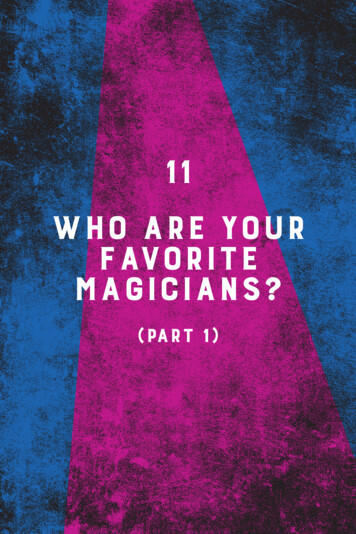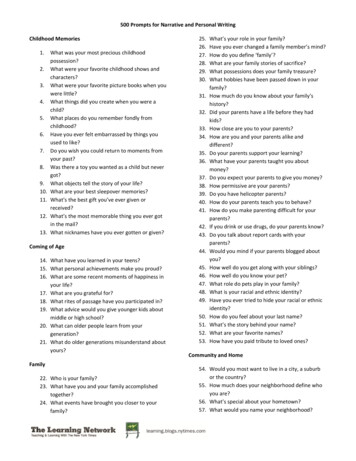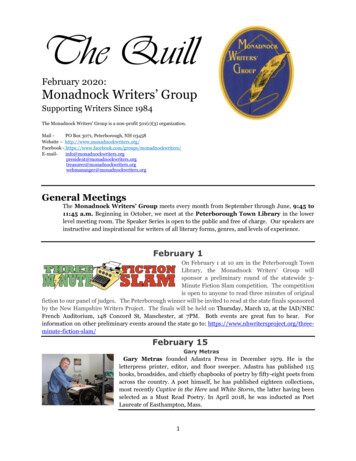
Transcription
11Who are yourfavoritemagicians?(Part 1)
The JOB OF THE ARTIST is alwaysto deepen the mystery.—Francis Bacon, artist There are several magicians whose work I admire above all others—Penn & Teller, David Copperfield, and David Blaine, to name a few.One of the most gratifying parts of writing this book is getting tospend time with each of them to learn about their processes. Butall of the magicians in this three-part series have one thing in common: You’ve probably never heard of them. Jerry AndrusM(1918–2007)agic is arcane. We magicians keep to ourselves, so much so thatsome of the best magicians in the world aren’t even professionals.They practice their craft between shifts or underneath their desks,away from the prying eyes of their bosses. Perhaps the most prolificmagician of all time—with more than two thousand original trickspublished—was a machinist in a factory. One of the finest sleightof-hand performers I’ve ever seen is a sales associate at FedEx.And then there is Jerry Andrus, a lineman for the Pacific PowerCompany in Oregon, one of the most creative magicians who everlived. When I met Jerry, I was just starting to perform on the magicconvention circuits. At that time Jerry was already a star, receivinghonors and ovations in the convention shows I was opening.51
HOW MAGICIANS THINKOne of the things that made Jerry unique is that from an earlyage he vowed to never tell a lie. Only with Jerry, it wasn’t lore—hewas serious. When I first heard about Jerry’s vow, the playful sideof me wanted to test it as soon as I met him.“What did you think of the guy with the doves?” I asked.“I don’t really care for that kind of magic,” he told me.I tried again. “Did you like the trick I showed you yesterday?The one where the coin appeared on top of the deck?”“It was over too quick.”Damn, I thought.It wasn’t just that Jerry never lied; it was his delivery thatresonated. He leveled blunt, unvarnished truths without an ounceof hesitation or coyness.Never telling a lie is hard enough in daily life. Try not to tellthe everyday white lies that get us out of dinner with neighborsor assure our kids what great artists they are. It’s not easy, butpossible, maybe. What’s hard to fathom is how a magician can go alifetime without telling a lie. And yet Jerry Andrus never lied, noteven onstage. He wouldn’t say, “Please choose any card you like,”unless you really had a free choice. It’s a brave, unnecessary, andartistic choice, and it makes performing magic almost impossible.Well, it would . . . for anyone but Jerry Andrus.Jerry’s second self-imposed guideline was yet another feat:He performed only original material. If someone else created it,he wouldn’t touch it. This is true in a general sense with othermagicians I admire, but Jerry was fanatical. He wouldn’t even usestandard moves in his effects. (It’s nearly impossible to explain tonon-magicians how impressive this is.) Magic, like everything, isbased on certain fundamentals. Everyone—and I mean everyone—uses these moves and a hundred others in their own sequencesand combinations. They are the building blocks of our craft. ButJerry invented his own sleight-of-hand vocabulary. Every move andmoment in his original magic was made up of a dozen or more original sleights. The sheer creative power required is staggering.52
Who are your favorite magicians? (Part 1)My favorite Jerry Andrus effect was called “Zone Zero.” Jerrydisplayed a large board with a hole in the middle of it. He then presented a bright yellow ball and placed the ball in the hole. When hedid, the ball disappeared. He would show both sides of the board,then reach his hand back inside “Zone Zero” to retrieve the ball.The effect is right out of a comic book, with holes that supposedlygo into other dimensions. Classic Jerry.Because he wasn’t a professional magician, Jerry carednothing for practicality. He was free to innovate without the constraints a professional worries about: angles, reset time, durability,or level of difficulty. He published a move in the 1950s called the“Sidewinder Shift,” where a chosen card was pushed through thedeck and secretly out the other side, concealed between the handand the wrist. It was so difficult that people didn’t believe it couldbe done. Having seen—or I should say, not seen—the “SidewinderShift” in action, I can say it was invisible and perfect in Jerry’soversized hands.Despite his low profile, Jerry is famous among magicians andknown also in the skeptic community. He was an outspoken agnostic who opposed pseudo-science in all its forms. His performancescould be heavy-handed at times, but he also offered explanations andcomfort to his audience as he fooled them. “I can fool you becauseyou’re a human,” he would say. “You have a wonderful human mindthat works no different from my human mind.” He wanted people to know that being fooled by something didn’t mean you werestupid.Among his many quirks, Jerry wrote poetry, invented his ownbutton-free dictation machine, and was a pioneer in an alternativelayout for the now-standard keyboard.In 2003, I found myself on tour in the Pacific Northwest andasked Jerry if we could meet up. He invited me to what he affectionately referred to as the Castle of Chaos, the home he had livedin since 1928. (After his death in 2007, a couple bought and restoredthe house, and it’s now a registered historic place open to visitors.)53
HOW MAGICIANS THINKThe house was comically small and in disrepair. It had a distinctive keyhole window in the front, and the whole property, insideand out, was, well, jerry-rigged. He had designed an organ that wasintegrated into the electricity of the house—as he played, lightsflickered on and off. The organ itself was a messy sea of wires thatlooked more like a homemade bomb than an instrument. He had atreadmill in his kitchen on which he mounted his computer—backwhen computers were huge and had separate towers attached tomonitors. I remember that a pan on his stove was incredibly filthy.“Jerry?” I asked, pointing to it.Without shame or interest, he replied, “I don’t wash my pans.”Jerry never lied.His backyard was what everyone—from neighborhood kids toJerry Andrus fans around the world—wanted to see. It was an optical illusions laboratory, filled with creations as big as cars, cobbledtogether with rotting wood and rusted-out nails. There were concentric rings hanging from the trees, which seemed to pass througheach other in impossible ways, and a sign with an arrow that alwaysseemed to point toward you, no matter where in his yard you werestanding. Whatever fame Jerry had as a magician and skeptic paledin comparison to his notoriety as an illusion designer. Many of theillusion toys you may have played with as a kid were created inJerry’s backyard. He was paid for a few of them, but he wasn’t thetype to patent his ideas or chase copyright infringements. I was toldhe died more or less penniless, which is not surprising, because hewas clearly unmotivated by money. Even while he was alive, museums featured solo exhibitions of his awe-inspiring optical illusions.“Box Impossible” is the signature Jerry Andrus illusion everyone wanted a selfie with, decades before selfies were a thing. It wasa box with no top and bottom, and when you looked at it from theright angle, your subject was both inside and outside the box at thesame time, an Escher drawing come to life. Much like Jerry himself,it begged for a second look.54
Who are your favorite magicians? (Part 1) Rune KlanI1976–n 2010, a clip emerged of a shocking, audacious magic trick.Denmark’s Rune Klan, a caustic comedy magician, borroweda woman’s shoe and proceeded to bake a bread roll inside it. Hepoured in flour, then water, then a pinch of salt, lit everything onfire, and—poof!—pulled a bread roll from the woman’s shoe.The woman happened to be the queen of Denmark. The clipwas a viral sensation, and to this day if you ask any Dane aboutRune Klan, they’ll respond, “The guy who baked bread in thequeen’s shoe?”Magicians have been baking cakes in borrowed hats for morethan seventy years, but using a shoe is somehow even more bizarre,particularly when it belongs to a monarch.Rune and I met as kids—he was twenty-one and I was fifteen.At an age when many of my nonmagician friends were spendingtheir summers at camp, I convinced my parents I was responsibleenough to tour the country doing magic shows and lectures. Runeand I toured the country together as “move monkeys,” the magicequivalent of skateboarders, our acts filled with unnecessarily difficult moves because, well, we could do them and most people couldnot. I learned from Rune that to be great, you had to be bold. I kneweven then that Rune was a genius destined for great things.Twenty years later, I believe he has achieved greatness. I’mbiased, of course, but Rune is performing the most innovativematerial in magic today. He’s famous now in Scandinavia and hasa Warholian Factory near his home, a large studio space in whichhe spends his days. It has a length of aerial silk chained to theceiling and a pop-up book the size of a Jeep. The tables are coveredwith prototypes and inventions, cobbled together with duct tape55
HOW MAGICIANS THINKand sloppy glue jobs. Local magicians pop in and out to work ontheir own material, and Rune will offer his help if he’s not askingfor some himself.Rune found fame early with an edgy comedic style that teenagers loved. But as he and his fans have matured, so has his comedy.In the beginning, he made fun of magic. He was an icon for theteens he played to—giant spliffs appeared from his mouth, a clothheld at crotch level “mysteriously” moved on its own, and when hetried to turn a washing machine into a raccoon, he “inadvertently”revealed a washing machine made of fur with a raccoon tail.On his first national tour, he wanted to open the show byappearing magically before the audience. His team built a sturdychamber of Plexiglas that would fill with smoke before he appearedinside. “It just wasn’t my style,” Rune explained. “It felt more likeCopperfield than me.” His solution was quintessentially Rune. Thelights went down in the theater as Carmina Burana blasted. Hugearrows pointed toward the Plexiglas box as it filled with smoke,the production values and garish music conjuring a Cirque duSoleil vibe. Then the music cut off abruptly, and a spotlight shinednear the wings of the stage. Rune walked on, sipping a beer. Hepointed to the box and said, “That would’ve been so cool if I wasin there, right?” It was absurdist, visual comedy, and the audienceloved it.But the shtick got stale. After a handful of tours and television specials, the same old routine wasn’t shocking anymore. Runewas older, and making fun of magic felt too easy. That’s when Runeblossomed into an artist.He reinvented himself with a series of penetrating conceptshows. In one, Rune partnered with some of the best musicians inDenmark and did beautiful, manipulative magic to live accompaniment, many of the tricks partially improvised each night. No twoshows were exactly the same.In Childless, his most recent creation, he explores the ten-yearstruggle he and his partner faced trying to conceive and, eventually,56
Who are your favorite magicians? (Part 1)adopt a child. There are laughs in the show as he parodies histhirty-something friends—the helicopter moms and dads—but it’smostly a heart-wrenching story of wanting a child and not beingable to have one. The magic in the show is beautiful, but the storymakes you weep.“If an idea does not scare me, I will not do it,” says performanceartist Marina Abramović. Rune is the same—restlessly provocative.My chief complaint about magicians, even great magicians, isthat they often lack vision. Magic is boundless in both scope andscale—few magicians master the art of close-up magic, and fewerstill can command a stage. They require totally different skill sets,yet Rune has both.All of Rune’s ideas sound like dead ends until I see them performed. “I’m going to do a card trick and talk about my dad’s death,”he said to me on the phone recently.“Okay,” I replied. What else could I say? It didn’t sound likemuch of an idea to me. But in a couple of years, I’ll see it onstage.And it will be wonderful. Richard TurnerR1954–ichard Turner can cut a packet of playing cards and, by feel andweight, tell you exactly how many cards he has cut. He can dealimperceptibly from the bottom and even the center of the deck.Turner, a Texan, has performed on television all over the world as“The Cheat,” a riverboat gambler–style character, often wearingrhinestone shirts and a flashy belt buckle. Offstage, he has excelledat Wadō-ryū karate and, as a sixth-degree black belt, earned thetitle of Master Turner. He has even invented a card game calledBatty that has a cult following related to the mathematical expertise required to solve it.57
HOW MAGICIANS THINKAlso: Richard Turner is blind.When Richard performs, his lack of sight is never mentioneduntil after his show, if at all. When the curtains part, Richard isalready seated at a card table flanked by spectators. He is engaging and funny and wildly impressive with his sleight of hand. Mostviewers never realize that he can’t see the cards or his hands or theaudience.I’ve never fully understood Richard’s artistic choice, but I’mnot in Richard’s shoes. It seems to me that the poetry—or maybe it’sthe paradox—of being one of the finest sleight-of-hand artists, whoalso happens to be blind, would be something to reveal rather thanconceal. Surely it would increase the audience’s appreciation forhis artistry. Stevie Wonder isn’t defined by his visual impairment,but it’s an essential part of his narrative and is evident in his lyricsand live performances. If the audience was made aware of Richard’sdisability, the reactions might be stilted or steeped in pity. Richard’schoice ensures that the audience defines his show by his exceptionalskill set—and nothing else.I know how Richard accomplishes his sleight of hand—withmore hours of practice than anyone I’ve ever known. I’ve never seenRichard without a deck of cards, even when we’ve shared a meal,during which he mostly practices perfect one-handed shuffles. Thething I most admire about Richard is how he achieved his level ofskill without the benefit of sight. Repetition practice is not unusualfor talented magicians, and practicing without vision isn’t an insurmountable obstacle. But the moves Richard has mastered areinvisible to the eye, and that requires fine-tuning the angles and thefinger positions of each hand. To achieve this, he is uncompromisingabout his technique. How does he know he’s not exposing somethingfrom the front angle? How does he know what part of the deck tohide at the right time? Richard is as good at cheating techniques asanyone I’ve ever seen. All the other cardsharps sit at home all daylong, staring into a mirror as they practice. Whereas Richard doesit all in the dark.58
Who are your favorite magicians? (Part 1)He’s nevertheless uncompromising about his technique. WhenI see him after a show, he’s normally critical of his performance. Italways looks flawless to me, but it “feels” off to him, an instinct hesurely trusts because he must do everything by feel. The UnitedStates Playing Card Company employs Richard as a touch analyst,helping them with quality-control issues on the texture and feel oftheir cards.Some years ago, before I ever shared a stage with him, Icalled up Richard and introduced myself. I told him I would beon tour in San Antonio and asked, sheepishly, if I might spend afew minutes with him to get an autograph. He invited me over tohis house, and we spent nine glorious hours together, exchangingsecrets.Sharing magic with Richard Turner is a unique experience.At his kitchen table, he knocked me out over and over, fooling mewith sleight of hand I couldn’t see, despite staring at his hands frominches away. But how could I show him my tricks?When I asked Richard for help with my bottom deal, he toldme he wanted to “see” it, then placed his hands on top of mine andasked me to do the move.“Too much tension in your left hand,” he began, like a doctor dictating a patient’s vitals to a nurse. “You should grip thedeck deeper, and you should flatten your fingers to get rid of thefinger flash happening as you take each card.” We spent severalhours at Richard’s kitchen table, the master and an apprentice.His hands rested on mine for a great deal of that time, and if anoutsider had been looking on, it might have appeared that I waslearning by osmosis, soaking up Richard’s decades of perfection.If only. 59
HOW MAGICIANS THINKRené LavandA(1928–2015)t first, it would appear that René Lavand had little in commonwith Richard Turner. He was from Argentina and spoke almostno English, and unlike Turner’s “The Cheat” persona, Lavandwas suave, weaving stories and poetry into his close-up magic.But Turner and Lavand have more in common than being twoelite sleight-of-hand artists. At age nine, they both developeddisabilities. Turner lost his vision, Lavand his right hand. Whileplaying at a carnival, René was hit by an errant automobile, andhis right hand was crushed. He wore a prosthetic for the rest ofhis life.Lavand came to magic later than most. He abandoned abanking career in favor of magic, first as a stage illusionist andeventually as a close-up magician. Lavand pioneered the powerful combination of storytelling and magic. His performances oftenstarted and ended with monologues that spanned topics as diverseas Pablo Neruda’s poetry, living with war, and Argentinian folklore.Because seemingly all magic tricks benefit from the use oftwo hands, Lavand had to invent his own physical “vocabulary” ofsleights. He devised ways to shuffle and secretly unshuffle a deckof cards with just his left hand. He learned to false deal from thebottom and second and third from the top. Nearly all vanishes,appearances, and changes are accomplished during a transfer fromone hand to another, whether it’s with cards or coins or—in the caseof Lavand’s signature trick—a wadded ball of bread. But without asecond hand to transfer to, Lavand devised an entire lexicon of newand wonderful sleights that effect these vanishes and changes withfive fewer fingers than anyone else.I first saw René when I was thirteen, at a show in Washington,DC. At the time I loved magic for what it was—something I usedto fool my friends at school, a purpose for my restless hands. ButRené Lavand offered more. As he manipulated the cards, he quoted60
Who are your favorite magicians? (Part 1)Picasso and Borges and talked about the magician’s role in our lives:“That’s why I’ve come here—to stimulate your sense of wonder,”he said. After his show I got to meet him, and I even managed tostumble through my own woefully inadequate trick for him, mythirteen-year-old hands trembling from start to finish.At certain moments in our development, people come into ourlives for just a moment and change the way we think about ourcraft or ourselves. Richard Turner and Rune Klan were instrumental to me because they weren’t over-the-top characters. ButRené Lavand was larger than life, unlike anyone I had ever met.He opened my eyes to the idea that there was a level beyond beinga great magician, that it was possible for a magician to be an artist. 61
magicians I admire, but Jerry was fanatical. He wouldn't even use standard moves in his effects. (It's nearly impossible to explain to non-magicians how impressive this is.) Magic, like everything, is based on certain fundamentals. Everyone—and I mean everyone— uses these moves and a hundred others in their own sequences and combinations.











